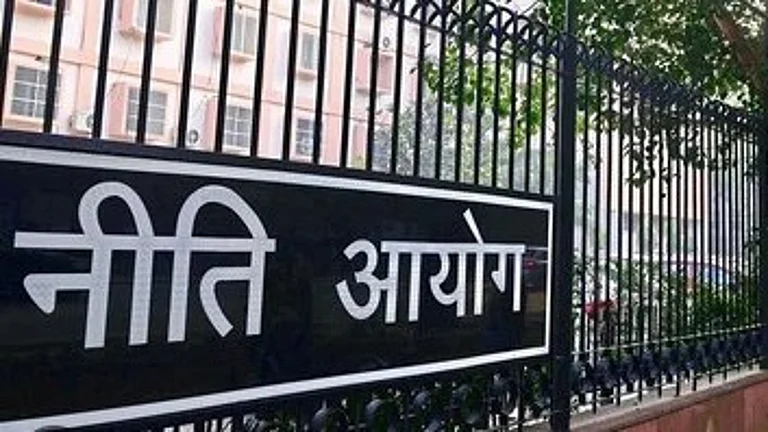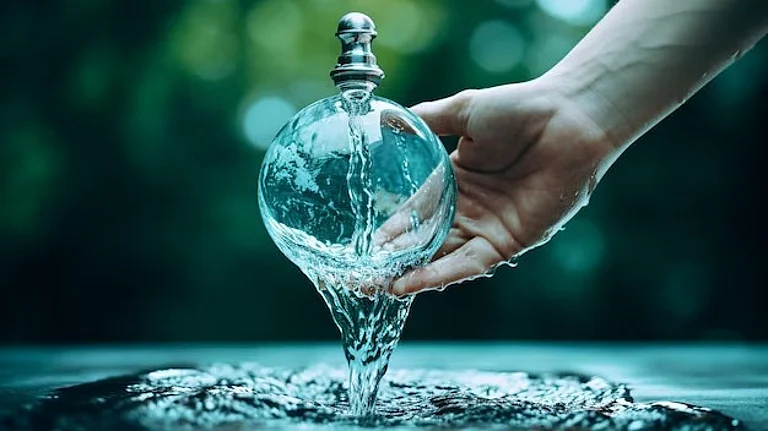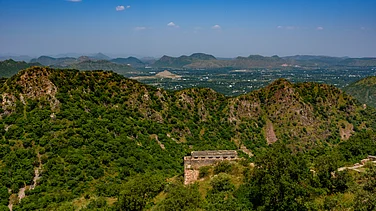Endorsed by Prime Minister Narendra Modi in his Mann Ki Baat for its contribution to water conservation, FluxGen is helping corporates like the Tata Group and Aditya Birla optimise their water usage. The company identifies inefficiencies across industrial water networks and provides real-time prescriptive alerts, notifications, and actionable insights to drive corrective action plans.
Casting his memory back to his childhood, FluxGen founder Ganesh Shankar recalls with a little shudder, how the well at his home in Bangalore dried up suddenly one day, robbing his family of a reliable source of freshwater. That memory from his schooling days was to define the mission that drives him every day of his life, now. In 2021, he roped in a bunch of passionate domain specialists from companies like L&T and Bluestar, and FluxGen was born. Its purpose was straightforward: leverage technology to help businesses walk back from the brink of a water crisis and achieve water neutrality.
The company digitises water infrastructure by deploying sensors across networks. Its solution uses physical sensors, satellite imagery and secondary data sources to supercharge monitoring capabilities and generate actionable reports that help businesses minimise waste and graduate to water neutrality. “What really sets us apart is how we combine AI, IoT, satellite data, and computer vision to create a deep-tech platform that can manage water with scientific precision. In a country like India, where we are facing a mounting water crisis, such a system is not just innovative—it’s absolutely essential,” says Ganesh Shankar.
Such ventures are spot on because India is staring at a critical tipping point in its water story. A recent NITI Aayog report warned that 21 Indian cities could run out of groundwater by as early as 2030. Industries, especially those with heavy water footprints like agriculture, textiles, steel, and beverages, are now navigating a changed reality—where securing sustainable water sources is a matter of survival. While some are reimagining operations, others still lag behind, constrained by policy gaps or a lack of foresight.
“As rainfall patterns are getting inconsistent in India, groundwater has become the biggest problem. Also, there is no alternate source for people to have water supplies like reservoirs, which leads to unchecked extraction of water through borewells,” says Viral Thakker, Partner and Leader - Sustainability & Climate, Deloitte South Asia.
The Growing Thirst – What’s Driving the Crisis
H2O is not just a chemical—it's the very DNA of economic growth, public health, agriculture, industry, and even political and social stability, which is why we need to worry about India’s escalating water crisis. According to NITI Aayog, nearly 600 million Indians already face high to extreme water stress, with climate change acting as an accelerant. Melting Himalayan glaciers—lifelines for rivers such as the Ganga and Brahmaputra—are expected to trigger dramatic downstream disruptions by 2047, the very year India hopes to realise its developed nation (Viksit Bharat) aspirations.
“As global temperatures continue to rise—from the current 1.4–1.5°C to 2°C or more—these climate change-provoked water challenges will spiral in the form of extreme rainfall, droughts, or glacial melt. Such phenomena disrupt natural water flow and availability,” says Abhishek of Niti Aayog Saxena, former Public Policy Expert at NITI Aayog.
An investigation by Thibi, a consultancy that works in the space between data and design, highlights another sobering dimension: the rampant over-extraction of groundwater to sustain thirsty cash crops. This not only jeopardises long-term water security but also depletes soil health, threatening national food security. Because aquifers are so intensively tapped, the little water that does percolate vanishes almost instantly, leaving none to replenish rivers or dam reservoirs.
The legal architecture governing water compounds the crisis. “Under the Easement Act, passed during British rule and still in effect today, landowners have the right to everything up to three feet below their land except in the case of groundwater,” said Crispino Lobo, Co-founder & Managing Trustee, WOTR. Below three feet, resources such as oil and minerals are considered public assets. However, water remains a privately held entitlement despite its vital, shared function—resulting in unrestricted pumping by landowners who face no obligation to monitor or conserve or share.
Industry in Action – Who’s Doing What
Hindustan Unilever’s flagship programme, Prabhat, aims to bolster water sufficiency in water-stressed regions surrounding its factories. The initiative focuses on improving water quality, rejuvenating water bodies, and strengthening local water governance through collaboration and knowledge sharing. It has so far generated water potential exceeding 130 billion litres. In a recent LinkedIn post, HUL CEO Rohit Jawa writes: “Through ‘Water for Public Good’, we continue to build water conservation potential. We have created over 3.2 trillion litres.” The success at HUL’s Chhindwara site reflects its water-positive actions: “It reduced specific water consumption by 50% and conserved 3.89 billion litres,” he notes.
Likewise, Coca-Cola Company’s water stewardship strategy combines efficient internal water use with wider ecosystem regeneration. The soft-drink major backed by its philanthropic arm, The Coca-Cola Foundation (TCCF), funds projects around the world to restore watersheds critical to communities, agriculture, and manufacturing. “We continue to make a difference by supporting collective action to sustain healthy, resilient watersheds for the people and places that need it most, from Africa’s Great Limpopo watershed to the forests of California,” says Carlos Pagoaga, President of TCCF.
“With industrial water consumption rising and climate risks becoming more severe, water is no longer just an operational issue—it’s a strategic one,” says Ganesh Shankar, underscoring how businesses must now elevate water management to the boardroom agenda.
However, a persistent challenge is usage monitoring and pricing. Industrial access to groundwater remains largely unregulated and, in many cases, unmetered. “In many cases, companies are allowed to draw groundwater without significant restrictions. There’s often no metering of how much water is being used. The question is, are they using water efficiently? Often, the answer is no. The cost they incur for sourcing water—whether from groundwater, tankers, or other supply channels—is much lower than the actual economic, environmental, and social value of that water,” said Abhishek of Niti Aayog.
Innovation & Technology – Tools of the Trade
Pune-based Watershed Organisation Trust (WOTR), which works with rural communities across India, has embraced modern technologies like satellite imagery and remote sensing to map topographies, water flows, and land use patterns. “We combine these insights with community participation to plan interventions—right from the upper reaches down to the river courses,” said Crispino of WOTR.
“The goal is to capture all the rain that falls within a village’s catchment. As you know, when rain hits hills, it collects into small streams, rivulets, and then rivers. We aim to retain as much of that water as possible where it falls—this is called in-situ water conservation or water harvesting,” he added.
The digital revolution is also sparking new approaches. Just as the electricity sector is investing in smart grids, experts argue that India now needs a "smart water grid"—a digitally governed distribution system that tracks usage, detects leakages, and flags unauthorised consumption.
“IoT (Internet of Things) is going to be a real game changer in bridging the real world and the digital world when it comes to water management. But I’d also highlight the role of hardware and process innovations—like membrane filtration technologies, which allow us to reuse wastewater, even for drinking purposes,” said Abhishek of Niti Aayog.
Policy Gaps and Pushes – Where Government Stands
The Indian government has rolled out several flagship initiatives to promote long-term water conservation. These include MGNREGS for rural infrastructure, the Jal Shakti Abhiyan for rainwater harvesting, Atal Bhujal Yojana for groundwater stewardship, and AMRUT 2.0 for urban water recharge. PMKSY focuses on irrigation and efficiency, while Mission Amrit Sarovar is dedicated to reviving local water bodies.
The 2012 National Water Policy aimed to address issues such as scarcity, inequity, and fragmented planning in water governance. However, recognising today’s more complex challenges, a new draft version is under development. The proposed revisions advocate for less water-intensive cropping suited to regional agro-ecologies, greater reliance on recycled water in industry, and a mandate to use treated wastewater for all non-potable urban needs. There is also a growing effort to encourage farmers to adopt less water-intensive crops, such as millets, especially in the country’s driest regions. Such moves recognise the fact that with limited scope for new large dams and declining groundwater quality, a decisive shift in policy from supply-side to demand-side thinking must now be the priority.
Conclusion
India’s looming water crisis is no longer just an environmental issue—it is a full-blown business imperative. The agility with which industries respond will define not only their sustainability but also that of the nation.
Policy alignment, inter-sectoral partnerships, and transparent governance mechanisms are critical. “One of the most important steps we need to take is large-scale watershed development. Groundwater aquifers are replenished by water that seeps through catchment areas, also known as watersheds. Unless we restore, conserve, and regenerate these areas—the lands that feed our rivers, streams, and underground water—we cannot solve the water crisis,” said Crispino of WOTR.
Just as importantly, participatory governance and shared problem-solving must become the new norm. Water use in rural India, in particular, requires structured oversight. The government must promote inclusive models that bring together state agencies, local communities, civil society, and industries.
Water, once regarded as a boundless input, has become a constraining metric. In the years ahead, businesses that treat water as a critical asset—equivalent to capital or energy—will be the ones that endure. The rest risk running dry.

































